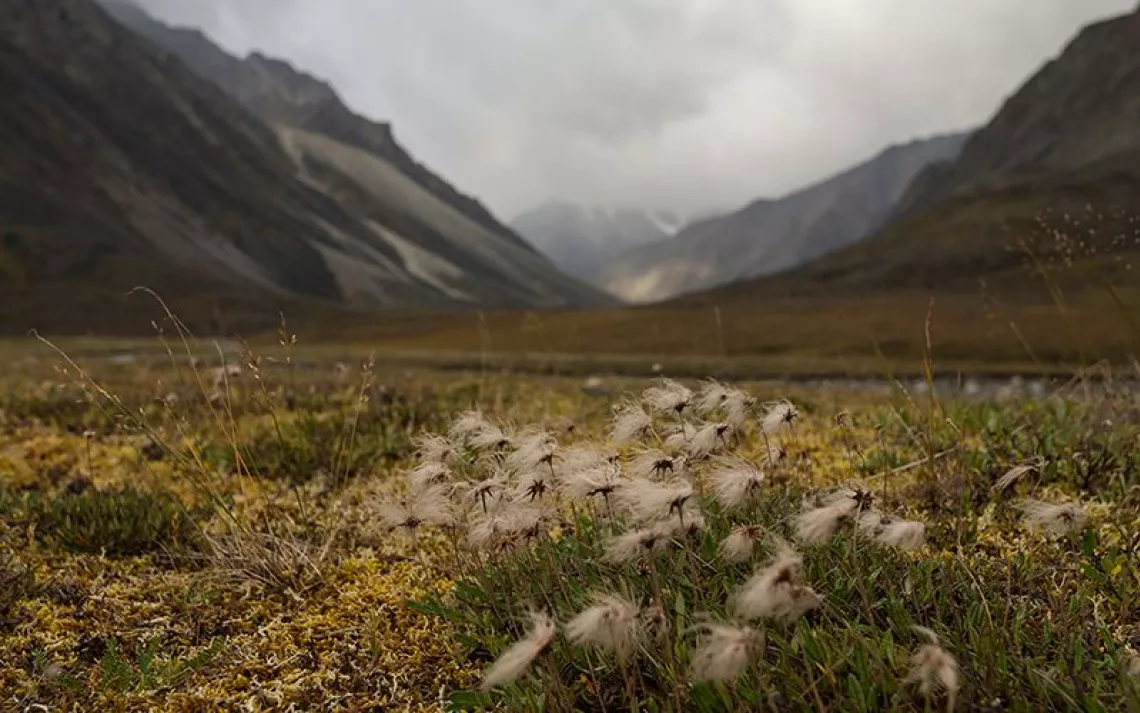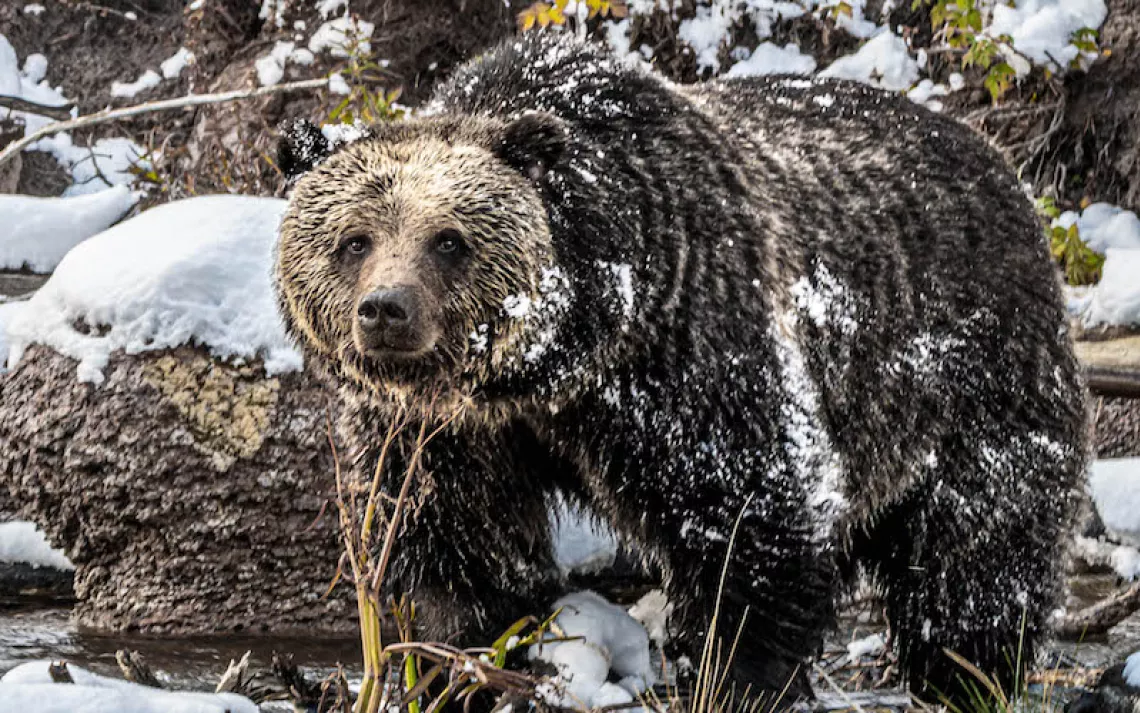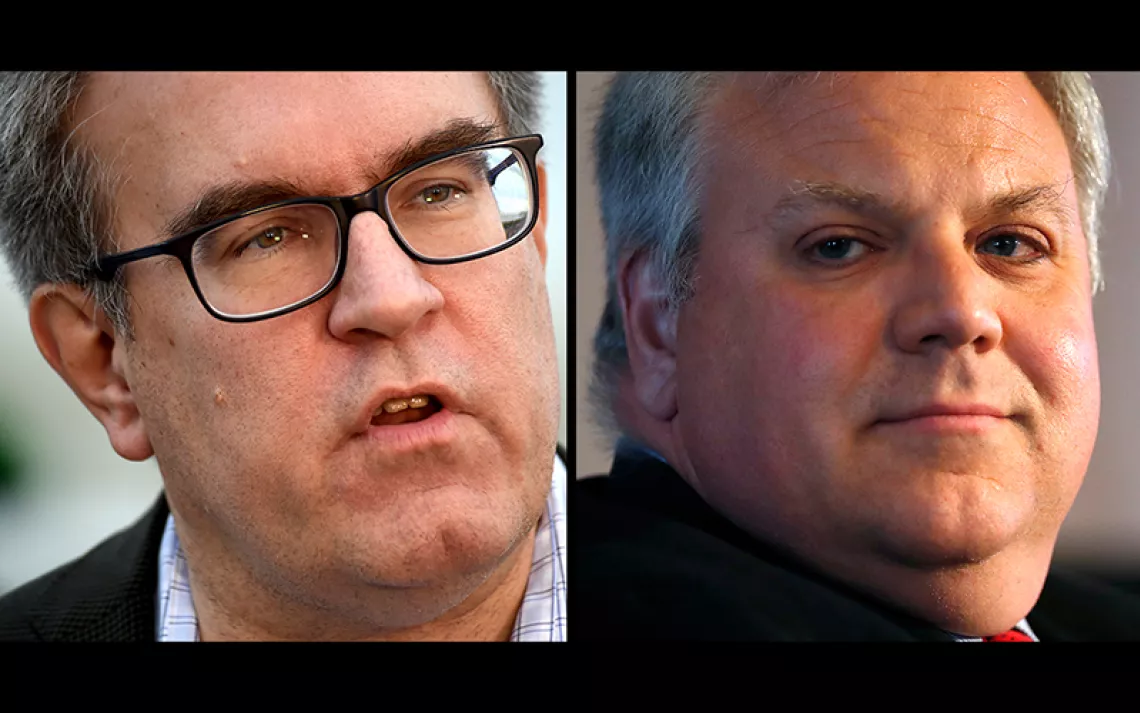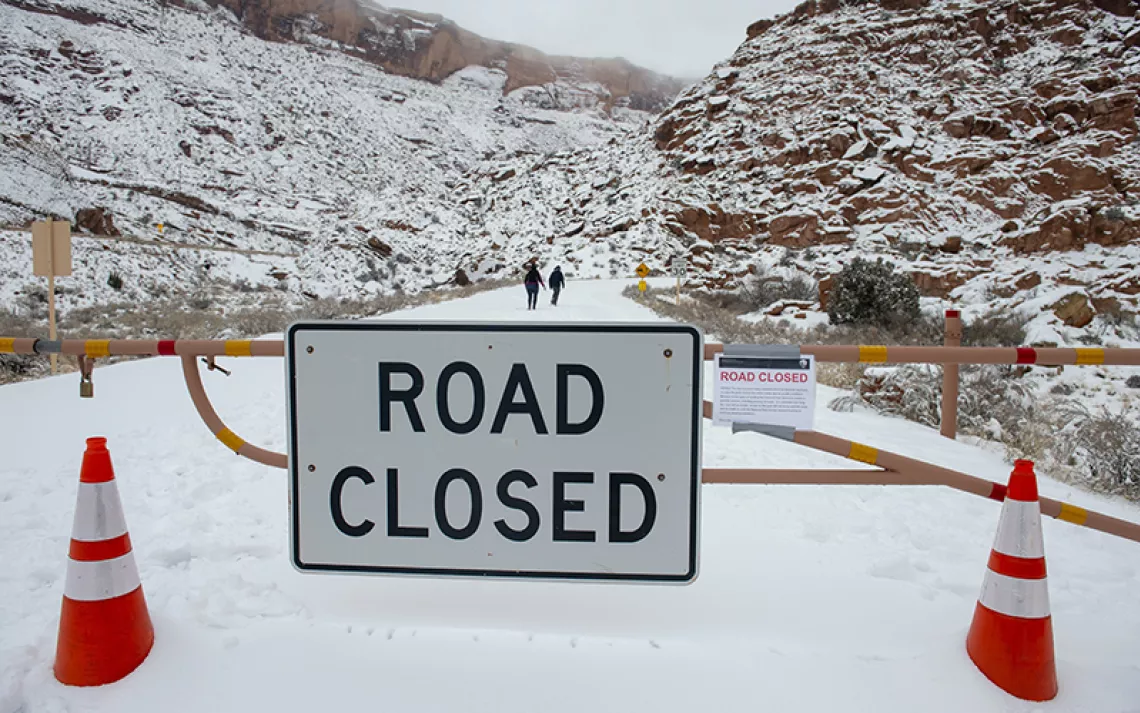Stewart Udall: A Remembrance
The 1960s interior secretary was a man ahead of his time. Now it’s time to remember him.
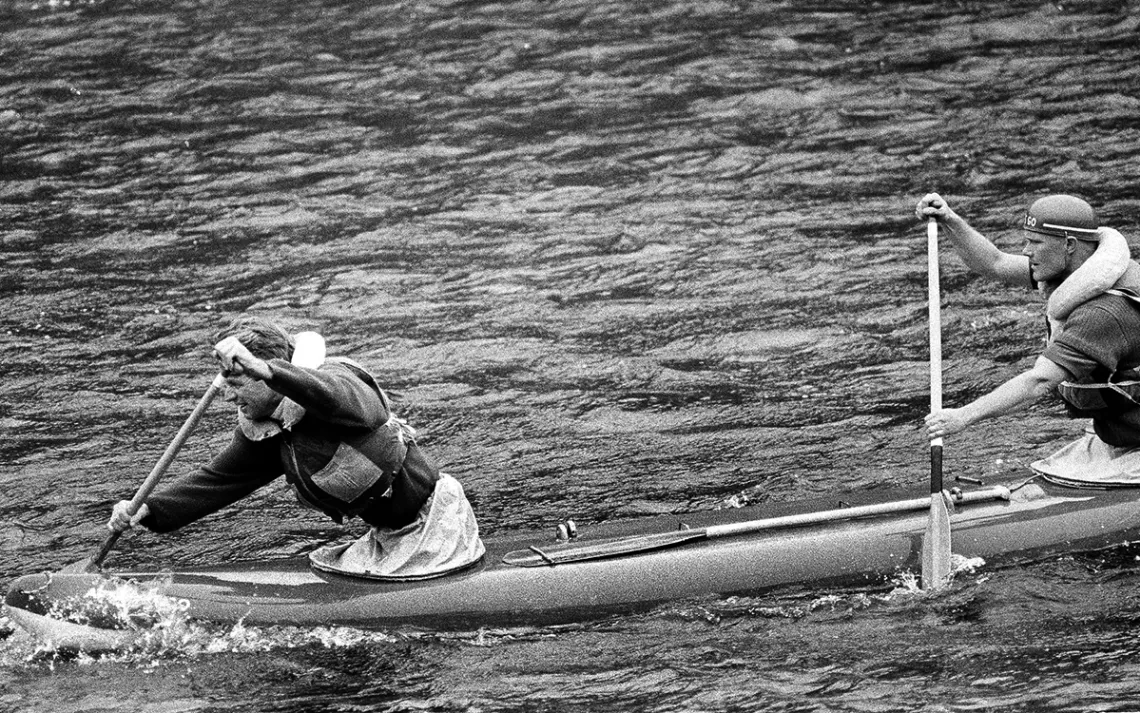
US Senator Robert Kennedy, who along with Interior Secretary Stewart Udall, joined about 100 other canoeists in the annual Whitewater Derby along the northern Hudson River, May 7, 1967. | Photo by AP Photo
Fifty years after the first Earth Day, it’s time to look back on what we accomplished in that heady era and to honor those who helped make possible the changes we have come to take for granted. We have made real progress, though some of these gains are now severely threatened. The air is far cleaner in Los Angeles and other cities than it was in the 1960s. The Cuyahoga River does not catch fire. Many once horribly polluted waterways are safe enough to swim in again. The number and extent of parks and trails have mushroomed, as has visitation. Hundreds of wild streams are protected against dams, and some dams have even been removed, resulting in resurgent fish populations. Bald eagles and peregrine falcons have rebounded from the brush with extinction that DDT and other chemicals brought them. And while there are still shameful exceptions to that progress—the water in Flint, Michigan, for example, and the lack of federal government action on climate change—we have much to be thankful for.
Many of the first responders and activists that we have to thank for that progress are today well known. For example, Aldo Leopold, who taught us about interconnectedness and the land ethic. Rachel Carson for her warnings of a “Silent Spring.” Lois Gibbs of Love Canal. Karen Silkwood. Erin Brockovich. The rainbow warriors of Greenpeace and countless others. Then there are the public officials who helped make environmental protection a mainstream concern. Senator Gaylord Nelson, Earth Day’s founder. Lyndon Johnson. Even Richard Nixon, who responded to the demands of Earth Day demonstrators—20 million of them on that first April 22.
There’s another political figure who, in the halls of government at least, was the leading prophet of environmental protection and sustainability: Interior Secretary Stewart Udall. Beyond the environmental history books and the memories of political junkies, Udall is too little known or recognized. And that’s a shame, because his accomplishments were unmatched and deserve to still be celebrated today. As President Barack Obama said when Udall passed away in 2010, “Stewart Udall left an indelible mark on this nation and inspired countless Americans who will continue his fight for clean air, clean water, and to maintain our many natural treasures.”
UDALL’S LEGACY
Stewart Lee Udall served as secretary of the interior under both John F. Kennedy and Lyndon Johnson. During that time, he provided the political leadership for a legacy that includes the original Clean Air and Water Acts, the Land and Water Conservation Fund, the Wilderness Act, the Endangered Species Act, the Highway Beautification Act, the Wild and Scenic Rivers and National Scenic Trails Acts, the Pesticide Reduction and Mining Reclamation Acts, the Solid Waste Disposal Act, the creation of a host of national parks and monuments, and large-scale funding for public transportation. Of course, in this he worked with activists like the Sierra Club’s first executive director, David Brower—who convinced Udall that the power dams the Bureau of Reclamation had proposed for the Grand Canyon would be tragically destructive. Udall also collaborated with political figures across the spectrum, especially Pennsylvania Republican congressman John P. Saylor. Most of his victories would have been impossible without his ability to win bipartisan support; today, many of them are being undone by the Trump administration.
But Udall was more than an environmentalist. With his younger brother, Mo, he challenged Jim Crow policies at the University of Arizona while both were students and basketball stars there in the 1940s. With support from President Kennedy, he forced the integration of the Washington Redskins football team in 1962. He spoke out for peace and against the Cold War, traveling that same year with poet Robert Frost to the Soviet Union to meet Khrushchev. He fought for compensation for the victims of atomic testing and uranium mining, reshaped the Bureau of Indian Affairs to respect tribal rights, and warned early on of the dangers of global warming. Several of his children continue his activism. His son, Tom, represents New Mexico in the United States Senate.
Udall was a prolific writer and speaker, authoring dozens of articles and nine books, including his noted environmental wake-up call, The Quiet Crisis. An advocate of the arts and humanities, he championed national endowments for both during the 1960s. He was an unabashed liberal who believed deeply in a robust government and the power of public policy to address the nation’s problems and promote a better quality of life for its people.
EARLY LIFE
It was an unlikely career for the son of Mormon ranchers who grew up without electricity and running water in St. John’s, Arizona, an isolated desert hamlet on the Little Colorado River. After serving as a Mormon missionary, Udall ran a machine gun during some 50 bombing sorties over Europe in World War II. Returning to Arizona, he played guard on the University of Arizona basketball team. Mo was the star and a center who later played a year of professional basketball with the fledgling Denver Nuggets.
When the Udalls were in college, the student cafeteria at the University of Arizona was still segregated; black students could not even eat there. In protest, Mo and Stew (as everyone called him) took African American friends to lunch there and forced the university to change its racist policy. Udall began a law practice after college, and in 1954, he was elected to Congress as a Democrat. He had a strong interest in the environment but was then an equally vocal supporter of the proposed power dams of the Central Arizona Project, believing they could make the desert bloom and bring economic development to his state.
While in Congress, Udall was struck by the charisma and leadership skills of fellow lawmaker John F. Kennedy. When Kennedy sought the Democratic nomination for president in 1960 against Lyndon Johnson of Texas, Udall led JFK’s campaign in Arizona, helping carry all of its convention delegates for the Massachusetts senator. “My dad believed that Camelot was real,” Udall’s son Denis says. “He believed Jack Kennedy could bring big changes to America, and he wanted to be part of that.”
INTERIOR SECRETARY
Kennedy repaid the favor by selecting the 40-year-old Udall as his secretary of the interior, in charge of many of the public lands of the West, the Bureau of Reclamation, the Bureau of Land Management, the Bureau of Indian Affairs, the National Park Service and other agencies. Udall won Kennedy’s support for several new national parks and seashores, and for action against air and water pollution. One of his great early successes was the passage of the Land and Water Conservation Fund, which draws from taxes on offshore petroleum drilling to fund parks, trails, open space, and outdoor recreation sites. It has been the prime funder for such amenities for nearly 60 years, though the battle to make it a permanent fund still continues in Congress.
Udall used his position as interior secretary to continue his opposition to racism, taking on the segregationist Washington Redskins, which in 1961 still would not hire black players. Udall successfully threatened the team’s owner with the loss of its stadium (DC’s national stadium was administered by the Interior Department) if the franchise didn’t integrate. With its newly hired black players, the Redskins were a much-improved team; some sportswriters humorously suggested Udall for NFL coach of the year.
When Udall discovered that the National Park Service had only one African American park ranger, he directed the NPS to launch a major recruiting campaign in traditionally black colleges. Robert Stanton, who later became the director of the NPS, credits Udall’s effort for helping make possible his career as a park ranger. He also reshaped the Bureau of Indian Affairs to give more power to tribal people. According to La Donna Harris, president and founder of Americans for Indian Opportunity, “Native Americans have a special place in our heart for the first interior secretary to recognize American Indians as self-determined peoples.”
Fearful of the possibility of nuclear war, Udall advocated cooling down the Cold War. He traveled to the USSR with poet Robert Frost on a peace mission to meet Soviet leader Nikita Khrushchev in 1962. A lover of poetry, Udall had become friends with Frost and had persuaded JFK to ask Frost to read a poem at his inauguration. Udall’s love for literature, art, and history led to active support for the National Endowments for the Arts and Humanities.
When Kennedy was assassinated in 1963, Udall was shattered. And in addition to his grief, he fully expected that because of his support for Kennedy against Johnson for the 1960 presidential nomination, he might well receive his walking papers from the new administration. But Johnson kept Udall on, and was actually far more open to his suggestions than Kennedy had been. Throughout his presidency, Johnson held a series of conferences on conservation In his “Great Society” speech at the University of Michigan in 1964, Johnson called on Americans to pay more attention to the quality of our lives and less to economic growth and the quantity of our goods.
UDALL AND THE FIGHT OVER DAMS
A mutual friend told Udall that the key to LBJ’s support was winning over his wife, Lady Bird. “If she wants it, Lyndon will do it,” the friend said. So, in August of 1964, Udall took the first lady on a rafting trip on the Snake River in the Grand Tetons. He urged Lady Bird to encourage her husband to launch campaigns for conservation and beautification, pointing out that Washington, DC, was an ugly city that was an embarrassment to the US in the rest of the world. “Stew Udall was a wonderful salesman,” Mrs. Johnson would later write. “He convinced me; this was for me!”
LBJ proved to be fertile soil for Udall’s intellectual seeds; he had grown up close to the earth on a Texas ranch and had a deep love for nature and natural beauty. He supported Udall’s calls for other environmental measures, including the Wilderness Act and Endangered Species Act and for new national parks and monuments. Indeed, in a phone call after setbacks in the 1966 midterm elections, Johnson told Udall he would have to cut his budget but not trim any money for parks. Johnson suggested that Udall cut back on some of the Interior Department’s dam projects, since the GOP would always fund dams, but not parks. Udall agreed.
But he still believed in one major dam initiative—the Central Arizona Project, a series of hydro-electric projects to bring water and electricity to the southwestern deserts. As an Arizonan, he knew how important these factors were to the economic vitality of the region. The initiative culminated in a plan to build two power dams right outside Grand Canyon National Park, backing up water into the canyon itself. Massive economic and political power—and, at first, Udall’s own instincts—stood behind the dams. Against them were environmental groups, most notably the Sierra Club, led by David Brower, who later founded Earth Island Institute and Friends of the Earth.
The Sierra Club had earlier agreed to one Colorado River Dam, the Glen Canyon Dam, just above Grand Canyon. But Brower had never seen the canyon. When he did, his failure to stop it became the great regret of his life. He was determined that such a thing should not happen to the Grand Canyon. Brower and the Sierra Club published a book of photos, The Place No One Knew, about what was being lost as the waters of Lake Powell began to fill Glen Canyon. Brower sent it to Udall. Harold Gilliam, later a San Francisco Chronicle columnist, but then a Udall aide, would later recount that Udall’s eyes glistened as he looked through the book. “I was in Congress when we voted for this dam,” Udall said sadly. “We had no idea what was there.” Soon afterward, Udall rafted through the rapidly filling canyon and then down the Colorado through the Grand Canyon, having second thoughts about the dams.
Udall decided he’d seen enough and stopped the project. In the PBS documentary For Earth’s Sake: The Life and Times of David Brower, Udall spoke softly but with determination about how he changed his mind. “The most important thing for any public official,” he told me,” is to be open-minded. And Brower changed my mind about the Grand Canyon. He showed me I was wrong. And for that, I’m in his debt, no question about it.”
In the Grand Canyon at least, the Colorado River still runs free.
THE VIETNAM CONUMDRUM
Politics is about hard choices, and for Udall the Grand Canyon dams were one of them. Even harder was his response to the war waging in a small Southeast Asian nation. Johnson had expanded the Vietnam War, sending US ground troops there in 1965. But some of Johnson’s advisers thought the war was a mistake and imperiled all of the progress of the Great Society on poverty, racial justice, and conservation. Udall was one of them. His brother had been the first member of Congress to openly oppose the war. Stew conveyed his concerns privately to Johnson, who made it clear that if Udall went public as Mo had, it would cost him his job. For Udall’s family, and especially for him, it was a moral conundrum of the first order. Udall decided that his protest would not affect the war but might threaten the immense conservation agenda he’d gotten Johnson to support. He held his tongue.
In 1968, anti-war senators Eugene McCarthy and Robert Kennedy announced campaigns against Johnson in the Democratic primaries. On March 31, Johnson shocked the nation by dropping out of the race. Udall was much closer to Bobby Kennedy than he had been to Jack, and Bobby shared Udall’s love for nature and his political ideas. They lived near each other in McLean, Virginia. Denis Udall, then an elementary schooler, remembers spending much time with Bobby and his kids. The Udall children loved him. When Bobby was also assassinated, a deep depression fell over the family. But Stew and President Johnson would have one last hurrah, on October 2, 1968, when, with Udall at his side, LBJ signed four important conservation bills creating Redwoods and North Cascades National Parks, and the National Scenic Trails and Wild and Scenic River Systems. Johnson honored Udall by remarking that future generations would remember his good works.
AFTER WASHINGTON
After Richard Nixon was elected president, the Udalls eventually left Washington. Udall spent more than a decade practicing law in Phoenix and acting as the lead attorney for the “downwinders”—residents of Utah and Nevada who had contracted cancer after exposure to atmospheric nuclear tests. He also represented Navajos whose tumors came from uranium mining. It took many years, but eventually they won compensation for their suffering, though many did not live to see it. In 1990, Stew and his wife, Lee, moved to Santa Fe so Lee could pursue her own passion—helping preserve and promote Native American arts—and Stew could continue writing. In all he wrote nine published books about history and conservation. While in Santa Fe, he grew active in the campaign against global warming, an issue he’d raised as early as the 1970s. Lee died of cancer in 2000. They’d been married 52 years. A few years later, Stew wrote a long letter to his many grandchildren. At 85, he had grown even more impatient for change:
“Eisenhower, in his much-admired farewell message, warned Americans to be wary of the growing military-industrial complex that would subsequently saddle the American people with the extravagant huge costs for an imperial presence in the world. Today our nation is spending more on military expenses than all the world’s other countries combined! It is instructive to listen to Ike’s advice about the use—and abuse—of military power...
“It is now time to redirect that sweat, genius, and hope in a brand-new direction. After a decade of dillydallying, it is clear that the world is waiting for the United States to step forward, as it did so often in the postwar period, and organize a bold agenda of technological cooperation that reverses global warming. A comprehensive action plan is needed that will inspire your generation to develop inventions that provide universal benefits for humanity…
“The challenges that your generation faces will test your ingenuity and generosity. Your eyes will scan horizons that human beings have never contemplated. Whether you are a person of faith who believes the Earth is the Lord’s and the fullness thereof, whether you are an individual who has had mystical experiences that link you to the network of eternity, or whether you are a fervent conservationist who wants to leave a legacy for your progeny, the earth needs your devotion and tender care.”
More than ever, as the current administration rolls back our environmental legacy and turns a blind eye to a warming planet, we need leadership and examples like Stewart Udall’s. He understood the issues of environment, peace, and justice as interconnected in “a single web,” and sensed that a love for art and beauty could inspire us to take better care of the planet.
Stewart Lee Udall died on March 20, 2010, at the age of 90. His memory must not.
 The Magazine of The Sierra Club
The Magazine of The Sierra Club
